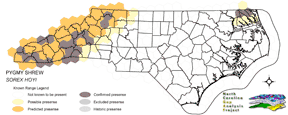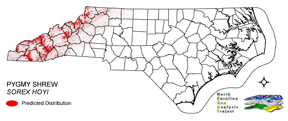
| Taxa: |
| Order: |
| Family: |
| Mammalia |
| Insectivora |
| Soricidae |
| NatureServe Global Rank: |
| NatureServe State (NC) Rank: |
| G5 |
| S3 |
| Federal Status: |
| NC State Status: |
| --- |
| --- |


| Land Unit |
| US Fish & Wildlife Service |
| US Forest Service |
| US National Park Service |
| US Department of Defense |
| NC State Parks |
| NC University System |
| NC Wildlife Res. Com. |
| NC Forest Service |
| NC Div. of Coastal Mgmt. |
| Local Governments |
| Non-Governmental Org. |
| Other Public Lands |
| Private Lands |
| GAP Status 1-2 |
| All Protected Lands |
| Statewide |
| Hectares |
| 0.00 |
| 170,577.36 |
| 63.00 |
| 69,926.49 |
| 3,202.92 |
| 53.28 |
| 3,865.14 |
| 814.77 |
| 0.00 |
| 4,731.30 |
| 4,786.65 |
| 8.28 |
| 383,354.55 |
| 99,487.44 |
| 257,864.13 |
| 641,383.74 |
| Acres |
| 0.00 |
| 421,505.75 |
| 155.68 |
| 172,792.09 |
| 7,914.59 |
| 131.66 |
| 9,550.97 |
| 2,922.05 |
| 0.00 |
| 11,691.29 |
| 11,828.07 |
| 20.46 |
| 947,289.54 |
| 246,747.48 |
| 638,104.72 |
| 1,585,802.13 |
| % of Dist. on |
| Prot. Lands |
| 0.0 % |
| 66.2 % |
| < 0.1 % |
| 27.1 % |
| 1.2 % |
| < 0.1 % |
| 1.5 % |
| 0.3 % |
| 0.0 % |
| 1.8 % |
| 1.8 % |
| < 0.1 % |
| 0.0 % |
| 38.6 % |
| ----- |
| ----- |
| % of Dist. on |
| All Lands |
| 0.0 % |
| 26.6 % |
| < 0.1 % |
| 10.9 % |
| 0.5 % |
| < 0.1 % |
| 0.6 % |
| 0.1 % |
| 0.0 % |
| 0.7 % |
| 0.7 % |
| < 0.1 % |
| 59.8 % |
| 15.5 % |
| ----- |
| ----- |
|
This shrew has the distinction of being the smallest mammal to presently inhabit North America (Allen 1979). Its distribution in the southern and mid-Appalachian mountain regions is not well defined. However, the few state records of occurrence for S. hoyi place its populations primarily at mid and upper elevations within the mountain region (Lee et al. 1982,
Linzey and Linzey 1971). These shrews make their homes in damp forested habitats or drier conditions near surface water (Allen 1979). They burrow beneath stumps and downed logs, into thick leaf litter and humus, or among rocks for shelter (Webster et al. 1985, Whitaker and Hamilton 1998). NATURE SERVE GLOBAL HABITAT COMMENTS: Found in a variety of habitats. Appears to prefer grassy openings of boreal forest. Moist habitats are preferred over dry areas. In Kentucky-Tennessee, much less active above ground than was S. LONGIROSTRIS (Feldhamer et al. 1993). Nest sites are not well known. |
| Code | Name | Description | NC Natural Heritage Program Equivalent |
| 230 | Piedmont Mesic Forest | American Beech - Red Oak - White Oak Forests. | Mesic Mixed Hardwood |
| 384 | Piedmont/Mountain Mixed Bottomland Hardwood Forests | Includes temporarily to seasonally forests dominated by hardwood species. Hardwoods include sweetgum, red maple, sycamore which co-occur in a mosaic of bottomland and levee positions. Includes alluvial hardwood forests in the mountains. Hemlock and white pine may occur as inclusions, but are generally mapped separately. | Piedmont/Mountain Alluvial Forest, Piedmont/Mountain Levee Forest |
| 383 | Piedmont Mixed Successional Forest | Generally loblolly mixed with successional hardwoods. Sweetgum, tulip poplar and red maple are common co-dominants in these successional forests. | No equivalent |
| 517 | Hemlock Floodplain Forest | Alluvial forest with hemlock and/or white pine in mountains and western piedmont. Hydrology is generally temporarily to seasonally flooded. | Canada Hemlock Forest |
| 521 | Spruce/Fir Forest | High Elevation Frazer-Fir - Red Spruce, Red Spruce and Red-Spruce-Yellow Birch Forests. Tree densities included here include both woodland to forest density. Highly intermixed with Northern Hardwoods, Grassy Balds, and Shrub Balds. | Red Spruce--Fraser Fir Forest, Fraser Fir Forest |
| 522 | Northern Hardwoods | High Elevation forests including yellow birch, American beech, and yellow buckeye. Includes forests with Hemlock and Yellow Birch. | Northern Hardwoods Forest, Boulderfield Forest |
| 523 | Grassy Bald | High Elevation grassy balds including Pennsylvania sedge, mountain oatgrass, as well as shrubby areas dominated by Alleghany and smooth blackberry. | Grassy Bald |
| 525 | Appalachian Oak Forest | A variety of oak forest types including Black, White, Scarlet Oaks in dry to mesic situations. Includes forests historically co-dominated by American Chestnut. | High Elevation Red Oak Forest, Montane White Oak Forest |
| 526 | Appalachian Cove Forest | Mixed Mesophytic forests of the mountains. Includes tuliptree, basswood, yellow buckeye and surgar maple. This class is mapped to include cove forests dominated or co-dominated by hemlock. | Rich Cove Forest, Acidic Cove Forest |
| 527 | Appalachian Hemlock | Upland hemlock forests of the moutains region. Vary from side slopes to steep slope positions. | Canada Hemlock Forest |
| 533 | Appalachian Swamp Forest | Evergreen and deciduous forests with saturated hydrologies. This class may contain a variety of trees species, including hemlock - red maple, pitch pine, and white pine forests. | Swamp Forest-Bog Complex, Southern Appalachian Bog, Southern Appalachian Fen |
| 534 | Appalachian Wet Shrubland/ Herbaceous | Saturated shrubs and herbaceous vegetation. Often mapped as an inclusion in Appalachian Swamp Forest. | Southern Appalachian Bog, Southern Appalachian Fen |
|
Long, C.A. 1974. Microsorex hoyi and Microsorex thompsoni. Amer. Soc. Mamm. Mammalian Species No. 33 pp. 3-4.
Wrigley, R.F., J.E. DuBois, and H.W. Copland. 1979. Habitat, abundance and distribution of six species of shrewsin Manitoba. J. Mamm. 60:505-520. Dierseing, V.E. 1980. Systematics and evolution of the pygmy shrews (subgenus Microsorex) of North America. J. Mamm. 61(1):76-101. George, S. B. 1988. Systematics, historical biogeography, and evolution of the genus SOREX. J. Mammalogy 69:443-461. Feldhamer, G. A., et al. 1993. Habitat partitioning, body size, and timing of parturition in pygmy shrews and associated soricids. J. Mamm. 74:403-411. Jackson, H. H. T. 1928. A taxonomic review of the American long-tailed shrews (genera SOREX and MICROSOREX). North American Fauna 51:1-238. Churchfield, S. 1992. The Natural History of Shrews. Cornell University Press, Ithaca, New York. 192 pp. Whitaker, J.O. Jr. and W.J. Hamilton, Jr. 1998. Mammals of the eastern United States. Cornell Univ. Press, Ithaca, New York. 583 pp. Lee, D. S., L. B. Funderburg Jr., and M. K. Clark. 1982. A distributional survey of North Carolina mammals. Occasional Papers of the North Carolina Biological Survey, No. 1982-10. North Carolina State. Mus. Nat. Hist., Raleigh, North Carolina. 72 pp. Linzey, Alicia V., & Donald W. Linzey. 1971. Mammals of the Great Smoky Mountains National Park. The University of Ten- nessee Press, Knoxville, Tennessee. 114 p. Banfield, A.W.F. 1974. The mammals of Canada. University of Toronto Press, Toronto. Godin, A.J. 1977. Wild Mammals of New England. Johns Hopkins University Press, Baltimore. 304 pp. Allen, Thomas B., 1979. Wild animals of North America. National Geographic Society, Washington, DC. 406 pages, color photographs. Whitaker, J. O., Jr., and T. W. French. 1984. Foods of sixspecies of sympatric shrews from New Brunswick. Can. J. Zool. 62:622-626. Baker, Rollin H. 1983. Michigan mammals. Michigan State University Press. 642 pp. van Zyll de Jong, C. G. 1983. Handbook of Canadian Mammals. 1. Marsupials and insectivores. Nat. Mus. Canada, Ottawa. 212 pp. Webster, W. D., J. F. Parnell and W. C. Biggs Jr. 1985. Mammals of the Carolinas, Virginia, and Maryland. The University of North Carolina Press, Chapel Hill, NC. Mengak, Micheal T., et. al. 1987. Abundance and distribution of shrews in western South Carolina. Brimleyana (13):63-66. Handley, C. O., Jr. 1991. Mammals. Pages 539-616 in K. Terwilliger, coordinator. Virginia's endangered species:proceedings of a symposium. McDonald and Woodward Publishing Company, Blacksburg, Virginia. Long, C.A. 1972. Notes on habitat preference and reproduc-tion in pygmy shrews (Microsorex). Can. Field-Nat. 86(2):155-160. |
For more information please contact them at:
NC-GAP Analysis Project
Dept. of Zoology, NCSU
Campus Box 7617
Raleigh, NC 27695-7617
(919) 513-2853
www.basic.ncsu.edu/ncgap